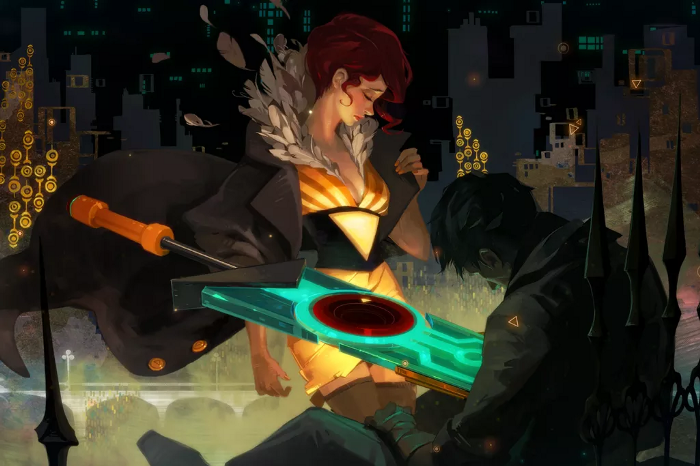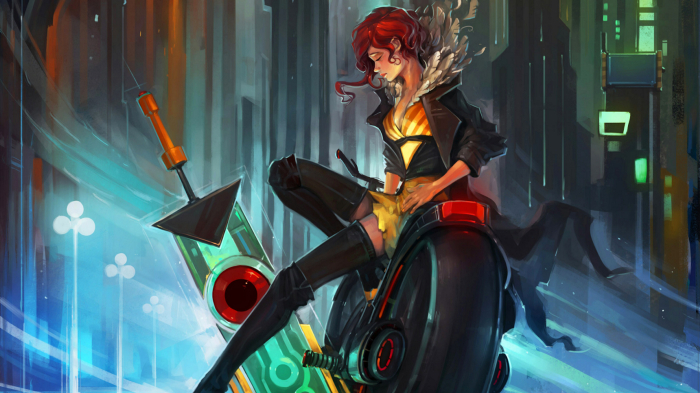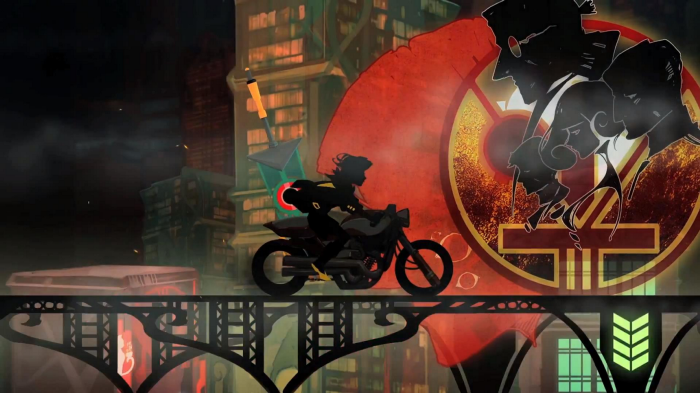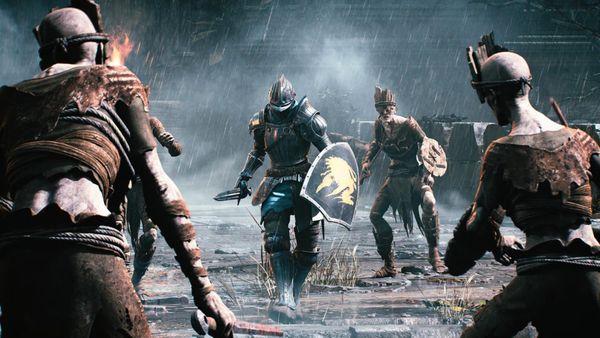Transistor doesn't understand itself
For a game about grief, Transistor sure isn’t sure how to deal with it.

Transistor, 2014, Supergiant Games
Transistor is a cyber-noire story following Red, a now mute-singer through Cloudbank on her journey vengeance and redemption, fighting against the Process with the aid of the mysterious Transistor weapon. It’s theoretically a game about loss, pain and art… but I can’t decide if it ever quite gets to its point, and if it does, I’m not sure it manages to do anything with its point.
I came to the game years after its release, and I’m still trying to unpack what it was trying to do, and if it gets there.
Red is a singer in Cloudbank, entertaining night after night with her brilliant singing. During a performance, the Camerata attempt to assassinate Red with a greatsword, the Transistor. They fail, instead killing Red’s associate, and somehow robbing Red of her voice. Now her voice is trapped within the sword, and the weapon narrates the game.
Red seeks vengeance on the Camerata, fighting her way through the city to kill the leaders of the organisation. She picks them off, one by one, but along the way it becomes quickly apparent the city is overrun by the Process.

The story is centrally about trauma, and the isolation of success in a world where technology has advanced far beyond our own. The Process are a sort of robotic, autonomous assimilating force that embodies the loss of Red’s ability to sing and create her art. While it is drenched in cyber-noir themes, the narrative is largely conveyed through subtext and obfuscation.
WHAT WORKS
- Narration: the narration throughout is brilliantly written. The lack of Red’s speaking in the game gives the whole thing a moody, detective vibe, doubled by the strength of the voice acting.
- Training Back Door: there’s this really cool recurring virtual reality space where you can step in. It’s cosy, beautiful, and is made by the first of the Camerata you slay. It embeds so much world building subtextually, and tells you an awful lot about who the person was who built it, merely from just experiencing the place.
- Silent Protagonist: the use of Red as the silent main character frees your brain up to focus on the combat, and then the narration as the pacing shifts and changes. And the pauses and way her silences are used really give her character a lot of definition.
WHAT DOESN’T WORK
- Bosses: the bosses lack the diegetic flavour of the rest of the story, and some of them feel straight up like they’re part of a video game, instead of an integration into the world.
WHAT IS IT ALL ABOUT
The story seems primarily concerned with mortality and creativity in a world where you select two disciplines, that combine to become your profession, more or less forever. Most things are voted on by the people in literal surveys, and much like Bioshock, a lot of the central characters you run into are artists or thespians in some way.
Red is a singer who has lost her voice in a world that’s slowly becoming overtaken by robots. The wild, curious streets of Cloudbank city are being erased by white, characterless structures. This isn’t so much a metaphor or simile, as it is a growing representation of Red’s internal emotions. As the game goes on, and Red fights harder and harder to defeat the Camerata, and by extension, hopefully claim back her voice, the more desperately bleak the city becomes. Red’s longing begins to dissolve into anger and panic, and as this happens, the consciousness within the Transistor begins to deteriorate and grow more and more unstable.
Red’s fighting prowess only grows as she battles fiercer and fiercer foes, fitting given the weapon she’s using to defeat them is a sword that has stolen her voice. The story is, in some ways, a metaphor for fighting against the gentrification and assimilation of artists. If Red is fighting the representatives of cold, creativeless order, she does so with a weapon literally made of her voice — she is defeating them with her singing.
The same set of thematic tools is extended to the use of technology, but seems at odds with the ideas above. Red’s attacks are powered by the weapon named Transistor — which in real life is a device that amplifies and switches electronic signals and output. In this way, the weapon becomes a conduit for Red’s expression, ironic given the very same tool now has her voice.

The themes and symbolism grow a little unsure as the story goes on, focusing on the consciousness within the sword, and the side players, who are all absent from stage, now represented only by the impact they left on the world. The story continues to be engaging, but the game’s thesis becomes a little more challenging to garner as things progress.
One piece of the puzzle that offers some clarity is the inclusion of Limiters, which are debuffs to make the game harder. They mean you are granted more experience, but if you play with them for long enough, you also uncover more of the game’s story and intricacies.
If we’re to take the above analogue of the fight for creativity as the central idea of the narrative, then adding these self-destructive training weights means you fail far more often, but have a more rewarding outcome. In this way, the story could be inviting us to think of art this way: the tortured artist will fail more, but in overcoming their struggle, they might perceive to have created something of more value.
This is at odds with how the villains of the story are cast. The individuals responsible for the Process, the members of the Camerata, intend to use the Process for good. Their creation of the Transistor was the method by which they would transform the city for better, but now they have lost control of their creations. You slay the first member of the Camerata, but coming upon the next two, they have sealed themselves in a tower, and before you arrive, they’ve taken their own lives. This is not a revenge story anymore, and if the game was really trying to say something about artists fighting against bureaucracy, then this throws a big spanner in that thematic consistency.
It remains a narrative hinging on longing. The man within The Transistor longs to have his body back, and during his degradation, expresses his longing for Red. Red is desperate to have her voice back, but by the end of the story, Red and the Transistor really only have each other as the city falls apart around them.
Regardless of how you read the meaning behind Red’s struggle and loss of her voice, the game’s story is richly told and bathed in subtle, interesting moments that string together to create an intricate, delicately rendered story about fighting against the futility of change, not unlike the very streets of Cloudbank city itself.



